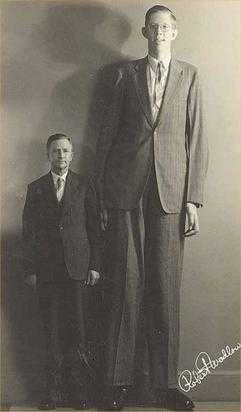Blood pressure.
Changing position would cause larger variations in blood pressure in the head and blood would be packed into legs. I doubt 10ft would be enough to cause huge problems, but adaptations similar to what giraffes have would exist if giants evolved naturally. This would mean larger heart and blood pressure to guarantee blood supply to the brain, valves to reduce blood pressure in the brain and prevent back flow when the head is down and tighter skin in the legs to prevent blood accumulating there. Alternately the circulatory system could have evolved to have pressure control valves for every major area allowing uniform pressure regardless of position. This would also allow giving muscles and lungs higher blood pressure while giving brain and other organs normal pressure.
Structure
Due to weight increasing faster than strength, bones and muscles would have to be proportionally thicker especially at the lower body. Legs would probably have suspensory ligaments at joints.
Superhuman?
Giants would by necessity be muscular in order to avoid issues with legs and spine. Being large and muscular would make them quite strong. Size alone would increase strength by the square of increase in height. Adaptations for increased mass would come on top of that, although possibly simply by weak giants not existing (less variation, not higher average). A giant might (as a guess) be two to three times as strong as a large and strong normal human.
Longer limbs would also add leverage and reach. So in melee combat a giant might certainly seem impossible for normal humans to defeat. They would normally get the first strike and should be able to use their overwhelming strength to push aside shields and parries.
Longer limbs would also allow using larger bows and arrows, which generally would result in dead opponents as size of the bow allows storing (and releasing) more energy with same pull strength and a larger arrow should be more accurate and have better armor penetration. And of course the giant probably would have higher strength as well.
The need for tighter skin for legs could result in the skin being thicker and more tear resistant all over. But I don't see this making much of a difference if weapons are used. Fat and muscle would absorb more damage than with a normal human as there would be more of them, but the difference should not be dramatic.
Weird scaling effects
After some thought I realised that bones and muscles are not the only things that would scale, if the same proportions were retained. Larger eyes would give more light gathering ability for better night vision and resolution would improve as well so that the giants would see as well at their arms length as normal humans at theirs. Sense of scent should also be scaled up.
Lung capacity could scale to match the need for oxygen (cubic), but the wind pipe would scale less, so the giants breathing would be much more audible and their voices would be louder. Also since the giants would have more mass generating heat in proportion to skin radiating it, they'd likely use panting for losing excess heat and possibly have a slightly higher body temperature.
The strangest question would be with the brains. If the proportions of the head remained the same the brains would be over twice the size of human brains. Considering that humans already have pretty big brains and it is hard to think need for more brain power, the giants heads might be flatter or have thicker bones to reduce brain size. The giants could have much more shock absorbing structures in their head.
Potential uses for extra brain mass are relatively easy invent, though. Many animals spend larger proportions of brain for sensory processing. The giants could have large structures for processing visual or scent data. They might have superior memory. On a world with magic the extra capacity could be reserved for magic and make the giants superior mages.

There are some 2.4 m tall humans. The tallest human was 2.72 m. – Fred – 2016-11-28T00:08:51.383
1Look to nature for inspiration: T-Rex, Elephants, Mammoths. Giant Sloths (Megatherium). – Serban Tanasa – 2015-01-12T03:15:08.003
@Serban ah okay, I feel I should clarify, I meant humanoid giants, as in, sort of like the kind from Skyrim. But thanks for the reply! – Feaurie Vladskovitz – 2015-01-12T04:04:10.193
On what time frame do you need these giants? With selective breeding and nuitrition alone, it would probably take dozens of generations to get to a 10 foot average adult height. If your in a hurry, its going to require genetic modifications. -- just noticed the fantasy-based tag. Substitute "magic" for "genetic modifications" in the comment above. – Henry Taylor – 2015-01-12T04:17:04.677
1@Henry thanks for the reply! But I'm not really asking about how they would be brought about, I'm more interested in what biological differences they would need compared to humans in order to function. – Feaurie Vladskovitz – 2015-01-12T04:41:22.550
I removed the bit about arrows as there is a separate question for that now. – Tim B – 2015-01-12T09:27:11.533
2
Related: http://www.popularmechanics.com/technology/digital/fact-vs-fiction/the-impossible-anatomy-of-godzilla-16785535
– Shokhet – 2015-01-12T23:33:48.180you have to see this article a scientific assesment of the pluasibility of game a throne giants anatomy. http://planetfuraha.blogspot.com/2016/06/the-anatomy-of-giants-in-game-of.html
– John – 2017-01-21T02:20:56.2431
What kind of gravity would they live in? Should we assume Earth standard? Also, there are humans who fall within that height range, what makes you think any changes would be needed?
– terdon – 2015-06-08T12:27:10.117